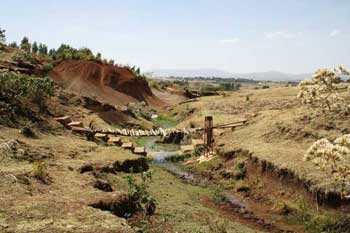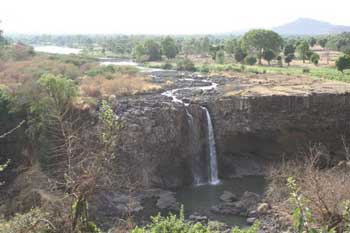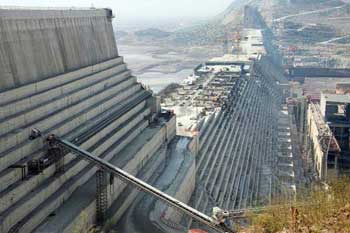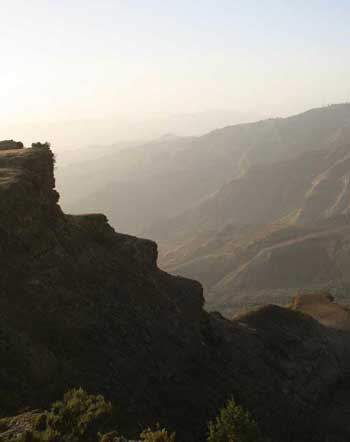[IAHR Talks] Interview with Professor Yilma Seleshi. Focus on the African region
#IAHRTalks
 “At the start of my career, only three universities provided engineering education. In the last 30 years the universities have grown to more than 30, located in various regions of Ethiopia, for which the department of Civil Engineering of Addis Ababa University contributed to the establishment of Civil Engineering program curricula, laboratories, and staff development through post graduate programs. Hydro-environment research though still has many unknowns in Ethiopia and problems and solutions are site-specific in many aspects...”
“At the start of my career, only three universities provided engineering education. In the last 30 years the universities have grown to more than 30, located in various regions of Ethiopia, for which the department of Civil Engineering of Addis Ababa University contributed to the establishment of Civil Engineering program curricula, laboratories, and staff development through post graduate programs. Hydro-environment research though still has many unknowns in Ethiopia and problems and solutions are site-specific in many aspects...”
This is a special opportunity for IAHR to convey the views of Prof. Yilma Seleshi, who has a broad experience in water resources projects, education and research in Ethiopia. During the interview he shared some of his thoughts concerning the development of hydro-environment engineering and research in the African context, the urgent needs in terms of water resources management, the impact of large engineering projects such as the Grand Ethiopian Renaissance Dam, and the contribution that our association can bring to all the raised issues.
Prof Yilma is a practicing hydrologist / water resources engineer, with experience in dam hydrology – flood, spillway sizing, reservoir operation, road drainage, and water resources system modelling. Presently an Associate Prof. in Hydrology at Addis Ababa University, Yilma’s background is in Civil Engineering (1987) with postgraduate study in Hydrology (1991) and PhD in Applied Sciences (1996), his dissertation: Stochastic Prediction of Seasonal Rainfall in Northeast Africa and India. Specialties: Hydrology, Seasonal rainfall prediction, Reservoir operation study, Drainage study and Water resources system.
David Ferras, editor of Newsflash World and Vice-Chair of IAHR technical committee on Education and Professional Development, interviews Professor Seleshi.
Dear Prof. Seleshi, could you briefly explain to us your story, i.e. the “why, where and how” concerning your interests in hydraulics and hydrology, your education and your development as a water professional?
During my childhood I already had a great interest in nature. I was always curious and enjoyed observing how water would flow in small channels and rivers. During my undergraduate studies in civil engineering at Addis Ababa University I discovered my preferred field, which is Hydrology. Coincidentally, in 1987, after my graduation, the government appointed me to the Hydrology Department of the Ethiopian Valley Development Studies Authority where I gained fresh experiences with senior hydrologists in office and field work. The Hydrology Department had been established earlier, during King Halie Selassie’s time, around 1965 by the United States Bureau of Reclamation (USBR)as part of the Ethiopia Blue Nile Water Resources Survey. Dr. Zewde Abate, Eng. Girma Bekele and Eng. Kidane Assefa, Eng. Negash Gemtesa, and Wondimu Kebede and others who were dedicated water resources experts are to be remembered for shaping my practical experiences. I carried out my postgraduate studies in Belgium at Vrije University of Brussels (VUB), in the Interuniversity Program in Water Resources Engineering, an international program where I learned advanced hydrology, hydraulics and water resources engineering aspects from passionate professors who loved water science and engineering, culminating with PhD research work on stochastic prediction of seasonal rainfall over North East Africa in 1996. Prof Alemayehu Tefera, Prof. Nigussie Tebedge from Addis Ababa University, Prof. Emeritus André Vander Beken founder of Hydrology at VUB, Dr. Gaston Damree from the Royal Meteorological Institute of Belgium and Prof Emeritus Jack Delluer from Purdue University USA, are always to be remembered for their dedication in guiding me to advanced knowledge in hydrology and to serve humanity where we are needed most.
 “The established science superpowers of the United States and Europe have dominated the research world since 1945. Yet this Atlantic axis is unlikely to be the main focus of research by 2045, or perhaps even by 2020.” (Jonathan Adams, 2012, in The rise of research networks). What do you think about this statement? Is Ethiopia going to be there one day? What research has been developed during the last decades and what is the current status and your vision for academic research in the field of hydro-environment in Ethiopia?
“The established science superpowers of the United States and Europe have dominated the research world since 1945. Yet this Atlantic axis is unlikely to be the main focus of research by 2045, or perhaps even by 2020.” (Jonathan Adams, 2012, in The rise of research networks). What do you think about this statement? Is Ethiopia going to be there one day? What research has been developed during the last decades and what is the current status and your vision for academic research in the field of hydro-environment in Ethiopia?
Consider that at the start of my career, only three universities provided engineering education. In the last 30 years the universities have grown to more than 30, located in various regions of Ethiopia, for which the department of Civil Engineering of Addis Ababa University contributed to the establishment of Civil Engineering program curricula, laboratories, and staff development through post graduate programs.
Hydro-environment research though still has many unknowns in Ethiopia and problems and solutions are site-specific in many aspects. Increasing numbers of hydro-environment researchers, increasing challenges as water development expands in Ethiopia and Africa, a growing research network, and improved availability of research work on the internet will drive African researchers to produce quality research and development products.
Academic research in the hydro-environment field in Ethiopia may focus on:
floods, sediment, low flows;
economical irrigation hydraulic infrastructure design, maintenance and management;
transboundary water management under climate change and changing socio-economic conditions;
river and floodplain management including catchments and wetlands;
eco-hydraulics / hydrology studies related to lake water invasive weeds.
Ethiopia has abundant water resources and yet there is a need to further develop sustainable infrastructure in the water, energy and food security nexus. Could you briefly number the most urgent priorities in this line?
Ethiopia has 11 river basins with a total annual renewable streamflow of 112 BCM. Among these 70 % of the water (77 BCM/year) is in the Ethiopia Nile basin (Tekeze, Abbay/Blue Nile and Baro-Akobo rivers). The other river basins, except Omo-Gibe, in the future, will barely have enough water resources for industrial and domestic water demands. Driven by population growth, climate variability/change and job creation, development of holistic water infrastructure to meet the increasing demand for water supply, food, and energy is required. In my view, immediate priority areas are large dam-based multipurpose development in the Blue Nile and Baro-Akobo basins for creating additional sustainable production of energy and food that will benefit Ethiopia and the whole region. The management of transboundary water resources, water governance practices bringing together professionals and stakeholders is essential for coping with the Ethiopian water challenges. There is also an urgent need for improving water supply and sanitation systems in rural areas, which is the sector that is most exposed to the lack of civil infrastructure.

Eleven countries and around 2.9 million km² of African land contribute to the magnificence of the Nile River. Is the Grand Ethiopian Renaissance Dam (GERD) agreement a political conflict with a technical solution or a technical problem with a political solution?
As any large dam in the world, the Grand Ethiopian Renaissance Dam (GERD) site location, design and construction aspects follow international standards and practices to which the consultant, contractor and the dam owner must adhere. This is technical. It is known that the useful economical life of large dams is longer, the economical return is attractive, and they provide a large array of multiple benefits for navigation, tourism and fishery. GERD, the 10th largest dam in the world, will double the present annual electricity output of Ethiopia raising it to about 29 TWhr/yr, and will provide keenly needed electricity to the growing industries, services, and agriculture sectors to catalyse the country’s economic, social, and environmental development. The benefit also extends to Sudan in flood protection, enhancing electricity generation, and provision of affordable electricity, as well as for the eastern Africa region, and will also benefit Egypt in flood and drought reduction under climate change uncertainty.
The political dimension emerges especially from the question concerning the “reservoir filling and operation”, being discussed under a circumstance in which there is no water sharing and management agreement among the Nile riparian countries. In a nutshell, the problem is that the Nile water resources have been almost fully consumptively utilized by Egypt and Sudan without taking appropriate measures to mitigate significant harm to the future water use of upstream countries (in Ethiopia case now dam filling). Under this situation, Ethiopia as generator of 84% of the Nile water will fill GERD and continue to utilize Ethiopia Nile rivers from its own reasonable and equable share of the Nile water without causing significant harm to downstream countries. In the long-term, the Nile riparian countries should make the Nile Cooperative Framework Agreement (CFA) operational which to date four countries ratified to manage the Nile River in a sustainable manner. You may refer to the Kevin et al. (2016) research paper on the cooperative filling of GERD for a more in-depth reading:
Kevin G. Wheeler, Mohammed Basheer, Zelalem T. Mekonnen, Sami O. Eltoum, Azeb Mersha, Gamal M. Abdo, Edith A. Zagona, Jim W. Hall & Simon J. Dadson (2016) Cooperative filling approaches for the Grand Ethiopian Renaissance Dam, Water International. 41:4, 611-634, DOI: 10.1080/02508060.2016.1177698.

In 2012 a delegation of IAHR representatives made a visit to Addis Ababa University. One of the goals of this visit was also to promote the forthcoming IAHR World Congress, where a special seminar devoted to African issues was programmed. If there was going to be a Special African Session in the next IAHR World Congress (Granada, Spain), what kind of African water issues would you like to be discussed?
The visit in 2012 had a great impact on our research community. This visit was a first step towards engendering more active collaboration between IAHR, Ethiopia and, in general, African countries. A Special African Session during the next IAHR World Congress would definitely be a confirmation of this commitment. The topics to be addressed in such a session should be aligned with the water resources priorities in Africa, which somewhat are also present in Ethiopia:
Transboundary water management under climate change and changing socio-economic conditions.
Affordable rural water supply development for the highland communities where groundwater is not available.
Challenges in tropical hydrology (flood, sediment, low flows, deforestation, and streamflow).
River and floodplain management including catchments, wetlands, and estuarine systems.
Echo-hydraulics studies related to lake water invasive weeds.
 In past NewsFlash interviews during 2019, with the IAHR Executive Director, Tom Soo, and with the President, Joseph Lee, both agreed that the association should follow up with that past initiative and strengthen its presence in Africa by pushing forward its regional division in the continent. As an academic and being involved in transboundary African projects, in what aspects do you think IAHR could better support research and professional development in the field of hydro-environment in Ethiopia and, in general, in the African context?
In past NewsFlash interviews during 2019, with the IAHR Executive Director, Tom Soo, and with the President, Joseph Lee, both agreed that the association should follow up with that past initiative and strengthen its presence in Africa by pushing forward its regional division in the continent. As an academic and being involved in transboundary African projects, in what aspects do you think IAHR could better support research and professional development in the field of hydro-environment in Ethiopia and, in general, in the African context?
There are multiple aspects in which IAHR could support the research and professional development in the field of hydro-environment in Ethiopia and, in general, in the African context:
Sustainable hydro-development and management aspects of rivers and lakes.Experience and knowledge sharing on the state-of-the-art design, construction and of hydro systems such as hydropower, water-supply, and water treatment systems
Managing transboundary water resources
Enhancing meaningful collaboration with key stakeholders such as the water affair ministers and increasing IAHR presence (Africa branch)
There are several pathways to start this up. In my opinion, maybe the most natural one is involving the young professionals. As I previously mentioned, during the last decades Ethiopian Universities grew a lot from three to thirty! As a result, there is a sudden growth in the number of young civil engineers and water resources experts. Our water professionals are, in general, young professionals. IAHR should attract young members to high level joint summits; an online or physical joint IAHR-Africa forum later in the year to discuss transboundary issues, the Nile and GERD dam. We can gather the IAHR experts at this forum (Sudan, Ethiopia, and Egypt). Also synergies might be established with other existing associations, such as the Ethiopia Civil Engineers Association, who are involved in hydro-environment engineering and research. A knowledge sharing platform could be created.
Our members, their views, knowledge, commitment, and experiences are what make IAHR a global leading association of hydro-environmental engineers, experts, researchers, and organisations. IAHR members’ voices and concerns guide the association on its continuing path towards a better future for water and the environment. Our members have a lot to contribute and we are listening to them so that we can put our collective voice forward.